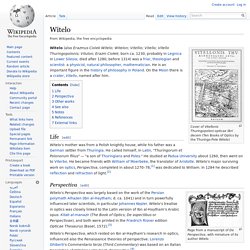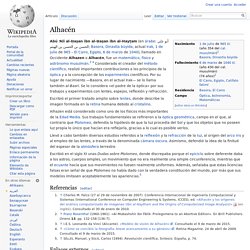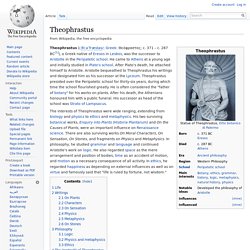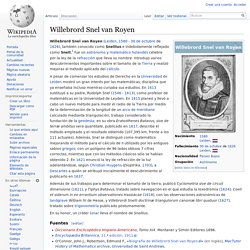

Witelo. Cover of Vitellonis Thuringopoloni opticae libri decem (Ten Books of Optics by the Thuringo-Pole Witelo) Life[edit] Perspectiva[edit] Page from a manuscript of De Perspectiva, with miniature of its author Witelo Witelo's Perspectiva was largely based on the work of the Persian polymath Alhazen (Ibn al-Haytham; d. ca. 1041) and in turn powerfully influenced later scientists, in particular Johannes Kepler.

Witelo's treatise in optics was closely linked to the Latin version of Ibn al-Haytham's Arabic opus: Kitab al-manazir (The Book of Optics; De aspectibus or Perspectivae), and both were printed in the Friedrich Risner edition Opticae Thesaurus (Basel, 1572).[3] Witelo's Perspectiva, which rested on Ibn al-Haytham's research in optics, influenced also the Renaissance theories of perspective. Perspectiva also includes Platonic metaphysical discussions. Other works[edit] In Perspectiva, Witelo refers to other works that he had written. Alhazen. In medieval Europe, he was honored as Ptolemaeus Secundus ("Ptolemy the Second")[10] or simply called "The Physicist".[11] He is also sometimes called al-Basri (Arabic: البصري) after Basra, his birthplace.[12] He spent most of his life close to the court of the Caliphate in Cairo and earned his living authoring various treatises and tutoring members of the nobilities.[13] Overview[edit] Biography[edit] Born c. 965 in Basra, which was then part of the Buyid emirate,[1] to an Arab family.[14][15] Legacy[edit] Front page of the Opticae Thesaurus, which included the first printed Latin translation of Alhazen's Book of Optics.

Alhazen made significant contributions to optics, number theory, geometry, astronomy and natural philosophy. One of the major scientific anniversaries that will be celebrated during the 2015 International Year of Light is: the works on optics by Ibn Al-Haytham (1015). Alhacén. Abū ‘Alī al-Ḥaṣan ibn al-Ḥaṣan ibn al-Hayṯam (en árabe: أبو علي الحسن بن الحسن بن الهيثم; Basora, Dinastía búyida, actual Irak, 1 de julio de 965 – El Cairo, Egipto, 6 de marzo de 1040), llamado en Occidente Alhazen o Alhacén, fue un matemático, físico y astrónomo musulmán.[3] [4] Considerado el creador del método científico, realizó importantes contribuciones a los principios de la óptica y a la concepción de los experimentos científicos.

Por su lugar de nacimiento —Basora, en el actual Irak— se lo llama también al-Basri. Se lo considera «el padre de la óptica» por sus trabajos y experimentos con lentes, espejos, reflexión y refracción. Escribió el primer tratado amplio sobre lentes, donde describe la imagen formada en la retina humana debido al cristalino. Theophrastus. Life[edit] Most of the biographical information we have of Theophrastus was provided by Diogenes Laërtius' Lives and Opinions of Eminent Philosophers, written more than four hundred years after Theophrastus' time.[2] He was a native of Eresos in Lesbos.[3] His given name was Tyrtamus (Τύρταμος), but he later became known by the nickname "Theophrastus," given to him, it is said, by Aristotle to indicate the grace of his conversation (from Ancient Greek Θεός "god" and φράζειν "to phrase", i.e. divine expression).[4] Theophrastus presided over the Peripatetic school for thirty-five years,[12] and died at the age of eighty-five according to Diogenes.[13] He is said to have remarked "we die just when we are beginning to live".[14]

Willebrord Snel van Royen. Willebrord Snel van Royen (Leiden, 1580 - 30 de octubre de 1626), también conocido como Snellius e indebidamente reflejado como Snell,[1] fue un astrónomo y matemático holandés célebre por la ley de la refracción que lleva su nombre.

Introdujo varios descubrimientos importantes sobre el tamaño de la Tierra y realizó mejoras al método aplicado del cálculo. A pesar de comenzar los estudios de Derecho en la Universidad de Leiden mostró un gran interés por las matemáticas, disciplina que ya enseñaba incluso mientras cursaba sus estudios. En 1613 sustituyó a su padre, Rudolph Snel (1546 - 1613), como profesor de matemáticas en la Universidad de Leyden. En su honor, un cráter lunar lleva el nombre de Snellius. Fuentes[editar] Volver arriba ↑ Encarta Winkler Prins, Grote Oosthoek, Eerste Nederlandse Systematisch Ingerichte Encyclopaedie.
Christiaan Huygens. Christiaan Huygens, FRS (/ˈhaɪɡənz/ or /ˈhɔɪɡənz/; Dutch: [ˈɦœy̆ɣə(n)s]) (Latin: Hugenius) (14 April 1629 – 8 July 1695) was a prominent Dutch mathematician and scientist.

He is known particularly as an astronomer, physicist, probabilist and horologist. Early life[edit] Portrait of Huygens' father (center) and his five children (Christiaan at right). Christiaan Huygens was born on 14 April 1629 in The Hague, into a rich and influential Dutch family,[3][4] the second son of Constantijn Huygens. Christiaan was named after his paternal grandfather.[5][6] His mother was Suzanna van Baerle. In 1644 Huygens had as his mathematical tutor Jan Jansz de Jonge Stampioen, who set the 15-year-old a demanding reading list on contemporary science.[11] Descartes was impressed by his skills in geometry.[4]